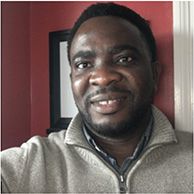Online Meeting with Talk on Portable NIR for Plant Phenotyping Reunites NY–NJ SAS Members
The New York and New Jersey Society of Applied Spectroscopy (SAS) has postponed its live meetings until the country gets back to a normal work schedule. In the interim, an online meeting schedule has been developed as a way to maintain the connection.
The New York and New Jersey Society of Applied Spectroscopy (SAS) has postponed its live meetings until the country gets back to a normal work schedule. In the interim, an online meeting schedule has been developed as a way to maintain the connection.
To kick off the new schedule, the The NY–NJ SAS regional section will continue to offer meetings online for all members who want to participate. To provide feedback or join the online meetings, please email Debbie Peru at debperu@outlook.com. A link to the webinar will be provided. SAS held an online meeting on April 29. Guest speaker Ugochukwu Ikeogu, a post-doctoral research associate at Cornell University (Ithaca, New York), discussed the use of low-cost portable near infrared (NIR) spectrophotometers for phenotyping and quality control testing for a range chemical and physical parameters in cassava root and ground powder. The title of his talk was “Portable NIRS: A Fresh Perspective in Cassava Phenotyping.”
Ikeogu is the project manager of the “VitisGen2” project in the horticulture section at Cornell University. He received his PhD from Cornell University in 2018 from the Section of Plant Breeding and Genetics. His research focused on high throughput phenotyping and genomics-assisted improvement in cassava.
Ugochukwu Ikeogu

Ikeogu developed a passion for phenotyping as a way to bridge the gap between advanced genomics technology and the need for more rapid and precise phenotyping for improving plant breeding, especially quantitative traits of plants. He initiated the rapid and field-based calibration and deployment of a portable visible and NIR (vis/NIR) spectrometer in line with strategies for genomic selection implementation in cassava. In his first post-doctoral appointment, he contributed to a pilot remote sensing effort using thermal and hyperspectral imaging, as well as transcriptomic and metabolomic profiling of stress responses in a model plant for a living surveillance to enhance national security (LiSTENS) initiative. Today, his research focuses on the adoption of new phenotyping and molecular marker tools for the improvement of wine, table, and raisin grapes under a multi-institutional research collaboration funded by the United State Department of Agriculture–National Institute of Food and Agriculture (USDA-NIFA) Specialty Crop Research Initiative.
The NY–NJ SAS regional section will continue to offer meetings online for all members who want to participate. To provide feedback or join the online meetings, please email Debbie Peru at debperu@outlook.com. A link to the webinar will be provided.
How Satellite-Based Spectroscopy is Transforming Inland Water Quality Monitoring
Published: April 29th 2025 | Updated: April 29th 2025New research highlights how remote satellite sensing technologies are changing the way scientists monitor inland water quality, offering powerful tools for tracking pollutants, analyzing ecological health, and supporting environmental policies across the globe.
Chinese Researchers Develop Dual-Channel Probe for Biothiol Detection
April 28th 2025Researchers at Qiqihar Medical University have developed a dual-channel fluorescent probe, PYL-NBD, that enables highly sensitive, rapid, and selective detection of biothiols in food, pharmaceuticals, and living organisms.
The fNIRS Glossary Project: A Community-Sourced Glossary of Key Terms
April 28th 2025Established to develop a community-sourced glossary covering key functional near-infrared spectroscopy (fNIRS) terms, including those related to the continuous-wave (CW), frequency-domain (FD), and time-domain (TD) NIRS techniques, the fNIRS Glossary Project features over 300 terms categorized into six key domains: analysis, experimental design, hardware, neuroscience, mathematics, and physics. It also includes abbreviations, symbols, synonyms, references, alternative definitions, and figures where relevant.